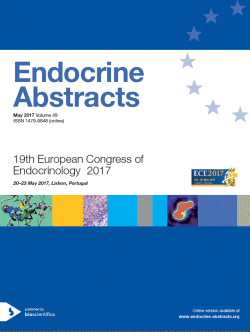
19th European Congress of Endocrinology
Lisbon,
Portugal
20 May 2017 - 23 May 2017
Guided Posters
Pituitary
ea0049gp173 | Pituitary | ECE2017
A comparison of single-dose effects of short acting somatostatin analogs: octreotide vs pasireotide in patients with active acromegaly after surgical debulking
Majos Agnieszka , Stelmachowska-Banas Maria , Czajka-Oraniec Izabella , Zgliczynski Wojciech
ea0049gp174 | Pituitary | ECE2017
Efficacy and safety of switching to pasireotide LAR alone or in combination with pegvisomant in acromegaly patients controlled with combination treatment of first-generation somatostatin analogues and weekly pegvisomant (PAPE study): a prospective open-label 48 week study, preliminary results 24 weeks
Muhammad Ammar , van der Lely Aart Jan , Janssen Joop , Neggers Sebastian
ea0049gp175 | Pituitary | ECE2017
Resistance to somatostatin analogues is associated with GSTP1 gene methylation and AHR rs2066853 variant in acromegaly patients
Ferrau Francesco , Romeo Petronilla Daniela , Puglisi Soraya , Ragonese Marta , Spagnolo Federica , Ientile Riccardo , Picerno Isa Anna Maria , Curro Monica , Visalli Giuseppa , Alibrandi Angela , Cannavo Salvatore
ea0049gp176 | Pituitary | ECE2017
Minimally Invasive Diagnosis and Direct Transnasal Surgery: a single centre series of 100 children with Cushing’s Disease with long term follow-up
Crock Patricia , Ludecke Dieter K , Knappe Ulrich , Flitsch Joerg , Saeger Wolfgang
ea0049gp177 | Pituitary | ECE2017
Octreotide subcutaneous (s.c.) depot, a novel ready-to-use formulation, provides higher exposure and maintains response in patients with acromegaly and functioning neuroendocrine tumours (NETs) previously treated with long-acting octreotide: Results from a phase 2, open-label, multicentre, randomized study
Ferone Diego , Borson-Chazot Francoise , Cailleux Anne , Horsch Dieter , lahner Harald , Pivonello Rosario , Tauchmanova Libuse , Darstein Christelle , Olsson Hakan , Tiberg Fredrik , Pavel Marianne
ea0049gp178 | Pituitary | ECE2017
Sleep patterns in patients with non-functional GHRH receptor
Oliveira Francielle T , Salvatori Roberto , Marcondes Jose , Macena Larissa B , Oliveira-Santos Alecia A , Faro Augusto C N , Campos Viviane C , Oliveira Carla R P , Costa Ursula M M , Aguiar-Oliveira Manuel H
ea0049gp179 | Pituitary | ECE2017
Correction of sustained hyponatremia secondary to SIAD by the use of chronic tolvaptan therapy is associated with a reduction in Emergency Room visits, hospital admissions and days of hospitalization over a 3-year period
Hernandez Martin Cuesta , Hernandez Irene Crespo , Alemany Pablo Amich , Hoyos Emilia Gomez , Gomez Nancy Sanchez , Santiago Alejandro , De Miguel Novoa Paz , Calle-Pascual Alfonso Luis , de la Vega Isabelle Runkle
ea0049gp180 | Pituitary | ECE2017
Outcome of non-functioning pituitary adenomas that regrow after primary treatment: a study from two large specialist UK centers
Tampourlou Metaxia , Ntali Georgia , Ahmed Shahzada , Arlt Wiebke , Ayuk John , Byrne James , Chavda Swarupsinh , Cudlip Simon , Gittoes Neil , Grossman Ashley , Mitchell Rosalind , O'Reilly Michael , Paluzzi Alessandro , Toogood Andrew , Wass John , Karavitaki Niki
ea0049gp181 | Pituitary | ECE2017
Targeting either GH or IGF-I levels during somatostatin analogue treatment in patients with acromegaly: A randomized, investigator-initiated multicenter study
Dal Jakob , Klose Marianne , Heck Ansgar , Andersen Marianne , Kistorp Caroline , Nielsen Eigil Husted , Bollerslev Jens , Feldt-Rasmussen Ulla , Jorgensen Jens Otto Lunde
ea0049gp182 | Pituitary | ECE2017
Brain white matter damage and volumes of hippocampus and hypothalamus correlates to cognitive function in craniopharyngioma
Fjalldal Sigridur , Svard Daniel , Follin Cecilia , Westen Danielle Van , Gabery Sanaz , Petersen AEsa , Jansson Magdalena , Sundgren Pia Maly , Bjorkman-Burtscher Isabella , Latt Jimmy , Mannfolk Peter , Nordstrom Carl-Henrik , Rylander Lars , Ekman Bertil , Johansson Aki , Erfurth Eva-Marie
ea0049gp183 | Pituitary | ECE2017
Copeptin – a sensitive marker of an altered CRH-axis in pituitary disease
Lewandowski Krzysztof , Lewinski Andrzej , Skowronska-Jozwiak Elzbieta , Malicka Katarzyna , Horzelski Wojciech , Brabant Georg
ea0049gp184 | Pituitary | ECE2017
Hormonal and metabolic effects of long-term cabergoline withdrawal in patients with hyperprolactinemia
Auriemma Renata Simona , Blasio Chiara , Grasso Ludovica Francesca Stella , Galdiero Mariano , Negri Mariarosaria , Pivonello Claudia , Granieri Luciana , Colao Annamaria , Pivonello Rosario



